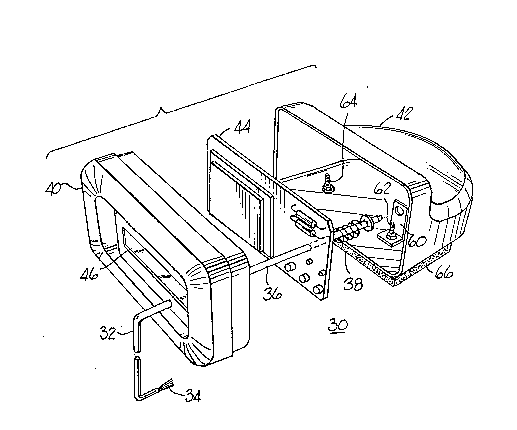Une partie des informations de ce site Web a été fournie par des sources externes. Le gouvernement du Canada n'assume aucune responsabilité concernant la précision, l'actualité ou la fiabilité des informations fournies par les sources externes. Les utilisateurs qui désirent employer cette information devraient consulter directement la source des informations. Le contenu fourni par les sources externes n'est pas assujetti aux exigences sur les langues officielles, la protection des renseignements personnels et l'accessibilité.
L'apparition de différences dans le texte et l'image des Revendications et de l'Abrégé dépend du moment auquel le document est publié. Les textes des Revendications et de l'Abrégé sont affichés :
| (12) Demande de brevet: | (11) CA 2129881 |
|---|---|
| (54) Titre français: | SYSTEME D'ELIMINATION D'ELECTRICITE STATIQUE POUR ORDINATEURS |
| (54) Titre anglais: | STATIC ELECTRICITY DISSIPATION SYSTEM FOR COMPUTERS |
| Statut: | Réputée abandonnée et au-delà du délai pour le rétablissement - en attente de la réponse à l’avis de communication rejetée |
| (51) Classification internationale des brevets (CIB): |
|
|---|---|
| (72) Inventeurs : |
|
| (73) Titulaires : |
|
| (71) Demandeurs : | |
| (74) Agent: | MARKS & CLERK |
| (74) Co-agent: | |
| (45) Délivré: | |
| (22) Date de dépôt: | 1994-08-10 |
| (41) Mise à la disponibilité du public: | 1995-02-12 |
| Licence disponible: | S.O. |
| Cédé au domaine public: | S.O. |
| (25) Langue des documents déposés: | Anglais |
| Traité de coopération en matière de brevets (PCT): | Non |
|---|
| (30) Données de priorité de la demande: | ||||||
|---|---|---|---|---|---|---|
|
Abstract of the Disclosure
A static electricity dissipation system for computers includes a
display/CRT antenna console that rests on top of the computer screen housing
and grounds the computer screen housing by means of a carbon foam member
attached to the underside of the display/CRT antenna console, a grounded metal
antenna extending from the front of the display/CRT console and having a
carbon fiber brush that is in physical and electrical contact with the
computer screen, a grounded conductor that is connected directly to the
computer CPU housing, and a strip of conductive carbon foam material that is
attached to the space bar or any other primary key of the computer keyboard to
continuously drain static charge away from the user. The display/CRT antenna
console includes an LCD display chip to provide a visual indication each time
an electrostatic charge on the user is dissipated.
Note : Les revendications sont présentées dans la langue officielle dans laquelle elles ont été soumises.
Note : Les descriptions sont présentées dans la langue officielle dans laquelle elles ont été soumises.

2024-08-01 : Dans le cadre de la transition vers les Brevets de nouvelle génération (BNG), la base de données sur les brevets canadiens (BDBC) contient désormais un Historique d'événement plus détaillé, qui reproduit le Journal des événements de notre nouvelle solution interne.
Veuillez noter que les événements débutant par « Inactive : » se réfèrent à des événements qui ne sont plus utilisés dans notre nouvelle solution interne.
Pour une meilleure compréhension de l'état de la demande ou brevet qui figure sur cette page, la rubrique Mise en garde , et les descriptions de Brevet , Historique d'événement , Taxes périodiques et Historique des paiements devraient être consultées.
| Description | Date |
|---|---|
| Le délai pour l'annulation est expiré | 1999-08-10 |
| Demande non rétablie avant l'échéance | 1999-08-10 |
| Réputée abandonnée - omission de répondre à un avis sur les taxes pour le maintien en état | 1998-08-10 |
| Demande publiée (accessible au public) | 1995-02-12 |
| Date d'abandonnement | Raison | Date de rétablissement |
|---|---|---|
| 1998-08-10 |
Le dernier paiement a été reçu le 1997-08-11
Avis : Si le paiement en totalité n'a pas été reçu au plus tard à la date indiquée, une taxe supplémentaire peut être imposée, soit une des taxes suivantes :
Veuillez vous référer à la page web des taxes sur les brevets de l'OPIC pour voir tous les montants actuels des taxes.
| Type de taxes | Anniversaire | Échéance | Date payée |
|---|---|---|---|
| TM (demande, 3e anniv.) - petite | 03 | 1997-08-11 | 1997-08-11 |
Les titulaires actuels et antérieures au dossier sont affichés en ordre alphabétique.
| Titulaires actuels au dossier |
|---|
| KEVIN L. COOTER |
| STEPHEN R. COOTER |
| Titulaires antérieures au dossier |
|---|
| S.O. |